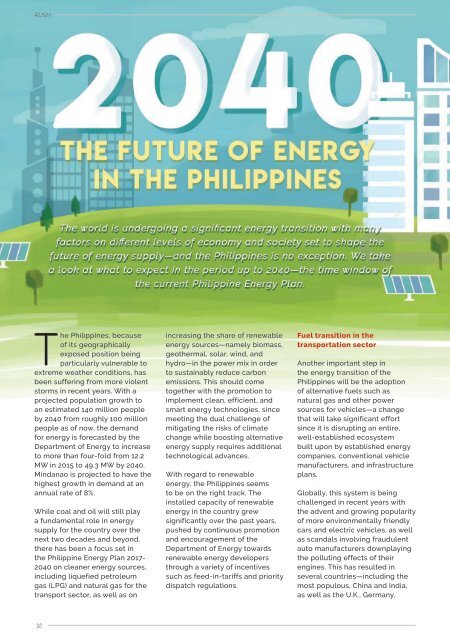RUSH June 2018
You also want an ePaper? Increase the reach of your titles
YUMPU automatically turns print PDFs into web optimized ePapers that Google loves.
<strong>RUSH</strong><br />
The Philippines, because<br />
of its geographically<br />
exposed position being<br />
particularly vulnerable to<br />
extreme weather conditions, has<br />
been suffering from more violent<br />
storms in recent years. With a<br />
projected population growth to<br />
an estimated 140 million people<br />
by 2040 from roughly 100 million<br />
people as of now, the demand<br />
for energy is forecasted by the<br />
Department of Energy to increase<br />
to more than four-fold from 12.2<br />
MW in 2015 to 49.3 MW by 2040.<br />
Mindanao is projected to have the<br />
highest growth in demand at an<br />
annual rate of 8%.<br />
While coal and oil will still play<br />
a fundamental role in energy<br />
supply for the country over the<br />
next two decades and beyond,<br />
there has been a focus set in<br />
the Philippine Energy Plan 2017-<br />
2040 on cleaner energy sources,<br />
including liquefied petroleum<br />
gas (LPG) and natural gas for the<br />
transport sector, as well as on<br />
increasing the share of renewable<br />
energy sources—namely biomass,<br />
geothermal, solar, wind, and<br />
hydro—in the power mix in order<br />
to sustainably reduce carbon<br />
emissions. This should come<br />
together with the promotion to<br />
implement clean, efficient, and<br />
smart energy technologies, since<br />
meeting the dual challenge of<br />
mitigating the risks of climate<br />
change while boosting alternative<br />
energy supply requires additional<br />
technological advances.<br />
With regard to renewable<br />
energy, the Philippines seems<br />
to be on the right track. The<br />
installed capacity of renewable<br />
energy in the country grew<br />
significantly over the past years,<br />
pushed by continuous promotion<br />
and encouragement of the<br />
Department of Energy towards<br />
renewable energy developers<br />
through a variety of incentives<br />
such as feed-in-tariffs and priority<br />
dispatch regulations.<br />
Fuel transition in the<br />
transportation sector<br />
Another important step in<br />
the energy transition of the<br />
Philippines will be the adoption<br />
of alternative fuels such as<br />
natural gas and other power<br />
sources for vehicles—a change<br />
that will take significant effort<br />
since it is disrupting an entire,<br />
well-established ecosystem<br />
built upon by established energy<br />
companies, conventional vehicle<br />
manufacturers, and infrastructure<br />
plans.<br />
Globally, this system is being<br />
challenged in recent years with<br />
the advent and growing popularity<br />
of more environmentally friendly<br />
cars and electric vehicles, as well<br />
as scandals involving fraudulent<br />
auto manufacturers downplaying<br />
the polluting effects of their<br />
engines. This has resulted in<br />
several countries—including the<br />
most populous, China and India,<br />
as well as the U.K., Germany,<br />
32



